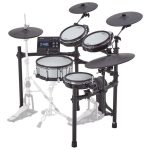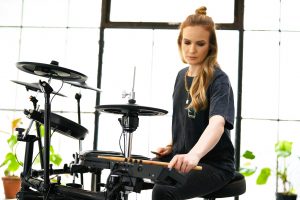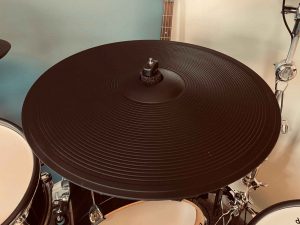The TD-27 is a high-end drum module, sitting just below the flagship TD-50X in the Roland range. It is available in five different kit configurations, including the acoustic-design V.A.D. series, and three traditional TD-27 electronic kits. Below, we’ll look at why you might want to consider the TD-27, what sets it apart, which version to buy, and what alternatives to consider.
Roland TD-27 Electronic Drum Kit Review
Considering buying a TD-27 drum kit? Learn about the module’s best features and which version of the TD-27 kit is worth buying
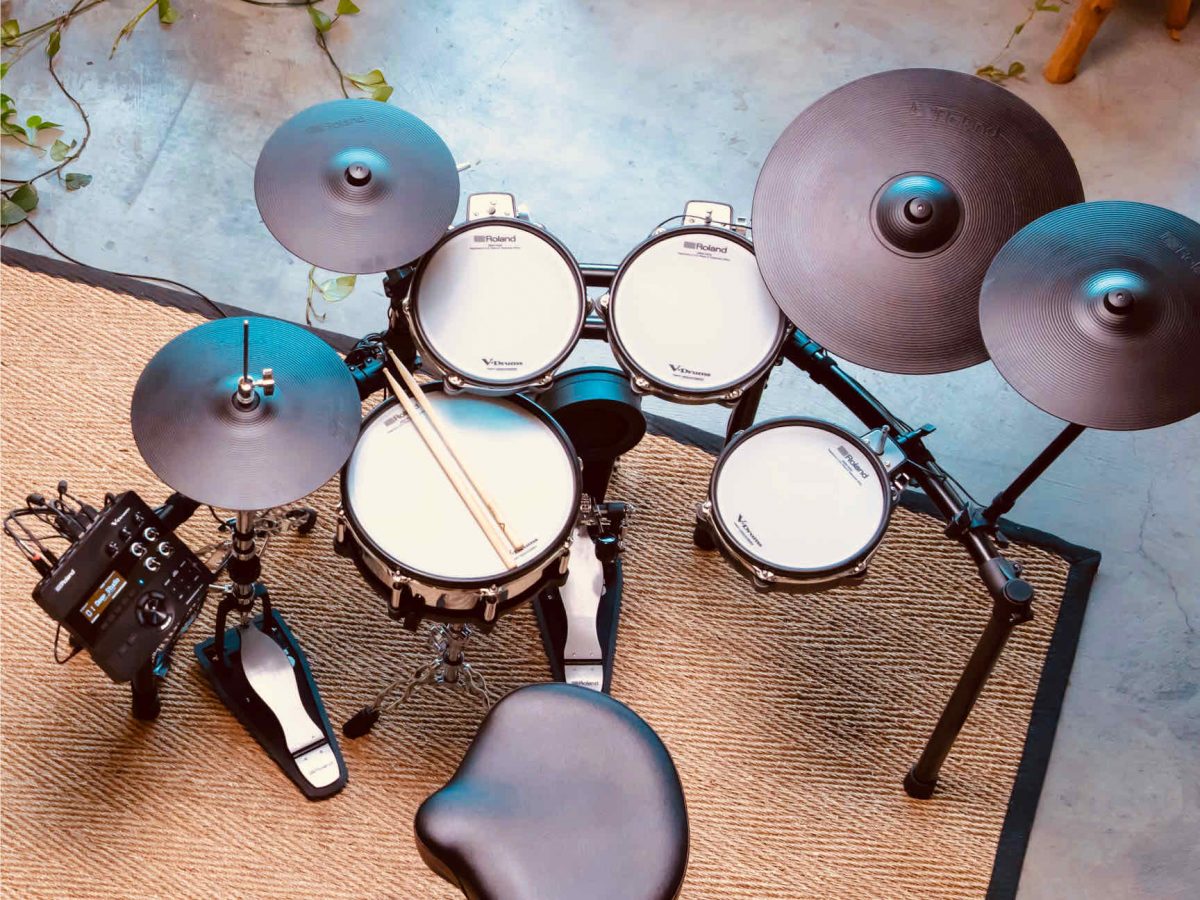
- Is the TD-27 a good module?
- Roland TD-27 module pros and cons
- Where does the TD-27 module fit in the Roland range?
- How good is the TD-27 hardware?
- What is the difference between a TD-27 and a TD-50?
- Does the TD-27 sound good?
- How many trigger inputs does the TD-27 have?
- What audio outputs does the TD-27 module have?
- About digital pad support
- How does Bluetooth work on the TD-27 module?
- How do I connect my Roland TD-27 to my computer?
- Which TD-27 drum kit should you buy?
- FAQs
- What alternatives are there to the TD-27?ol>
Is the TD-27 a good module?
The TD27 overall is a very good drum module, improving over its predecessor, the TD-25, with two extra trigger inputs, and support for all three of Roland’s newest digital pads. The TD-27 offers many of the features from the TD-50X at a much more affordable price, though still coming in at the upper end of the eDrum market. The only notable downsides with this module is the use of a cable snake instead of individual trigger input jacks, and module sounds that aren’t quite at the level of VST drum software.
Roland TD-27 module pros and cons
| Pros | Cons |
| Support for Roland’s high-end digital snare, ride and hi-hat pads | Most of the trigger inputs are connected via a multi-core cable snake instead of individual jacks |
| Support for one-shot samples via SD Card | Module sounds are still not VST quality and can have a synthesised sound to them |
| Headphone, master and direct outputs, with customisable audio output to each |
Where does the TD-27 module fit in the Roland range?
The Roland TD-27 module fits into the upper-mid price bracket of Roland’s range, sitting above the TD-17 but below the flagship TD-50X. It is essentially a cut-down, compact version of the TD-50X, with support for the same three digital trigger inputs and using sounds derived from the TD-50X.
How good is the TD-27 hardware?
The non-V.A.D. versions of the TD-27 come with the MDS-STD2 drum stand. This uses similar components to the stand that comes with TD-17 kits, only with a wider centre section which allows more flexibility in your set-up.
The increased space means you could relocate your second tom and ride cymbal for a one-up-two-down configuration, or mount additional pads and cymbals to make use of the aux trigger inputs.
I’ve owned this exact stand for many years, since this is an example where Roland uses a tried and tested design over more than one generation of products. The tubes on the stand are chunky and made from metal, while the mounting brackets are generally plastic. This might not sound that durable, but I have had no issues, with even heavy pads staying in place over years of use.
Pads and cymbals on the TD-27 are similarly very robust, and the reason why Roland has such a strong reputation in the industry.
What is the difference between a TD-27 and a TD-50?
There are a few differences between the two modules which elevate the TD-50 and 50X to flagship status above the TD-27. Below, we can see how the two modules compare:
| TD-50 | TD-27 | |
| Standard trigger inputs | 14 | 12 |
| Trigger input connection | Separate inputs | Cable snake + 4 separate inputs |
| Digital trigger inputs* | 3 | 3 |
| Balanced direct audio outs | 8 | 2 |
| Unbalanced master-out | Stereo/mono | Stereo/mono |
| XLR master-out | yes | no |
| MIDI connectors | In & out/thru | In & out/thru |
| Footswitch | yes | yes |
| USB interface | MIDI & 10-channel audio recording (50X: 32 channels) | MIDI & 28-channel audio recording |
| SD Card | yes | yes |
| Bluetooth | no | yes |
| Mix-in | yes | yes |
| Drum kits | 100 | 100 (75 presets) |
| Instruments | 400+ | 728 |
| Max. no. user samples | 500 | 500 |
| Physical fader controls | 8 | none |
| Multi-effects | 30 | 30 |
* Note that the digital trigger inputs on each module cannot be used in addition to the corresponding standard input, for example, the analogue snare input cannot be if a digital snare is plugged in
Overall, the TD-27 gets very close to the TD-50, with nearly as many trigger inputs, including digital trigger support, but lacking in audio-output options and relying on the multi-core cable snake instead of individual trigger input sockets across the board. However, the TD-27 adds Bluetooth which the TD-50 lacks, and supports 28-channel audio recording while the older base model TD-50 only supports 10 channels.
The main benefit of stepping up to a TD-50X or a used TD-50 is the extra audio output options, which are beneficial for drummers using their eDrums on stage. The XLR outputs offer a convenient way to plug into a PA system directly, or alternatively, the 8 balanced TRS direct outs offer more flexibility for EQing individual instruments than the stereo-out on the TD-27.
Does the TD-27 sound good?
The sounds on the TD-27 are derived from the flagship TD-50 and sound very similar. The presets are a dramatic upgrade over older kits like the TD-25 or TD-11. But in my opinion, they still sound a bit synthetic and not quite as good as a VST instrument such as Superior Drummer 3.
The toms in particular can still generate a “machine gun” effect, which describes the robotic sound when you play fast rolls. VST drum libraries, by comparison, tend to sound more real because they use more samples of the same drum, which alternate randomly as you repeatedly strike the drum. This mimics playing an acoustic drum, where you’ll not hit the drum exactly the same way each time, resulting in a more human feel.
Whether or not you like the built-in drum sounds is subjective, however, so it’s best to listen for yourself:
How many trigger inputs does the TD-27 have?
The TD-27 has 12 trigger inputs, counting the dual-cable ride and hi-hats as one input each. A total of 12 is achieved using the Roland multi-core cable snake for 8 inputs, plus four individual trigger inputs on the module for expansion. One is intended for a second crash but can be configured for any pad, while the other three are labelled as aux 1,2 and 3.
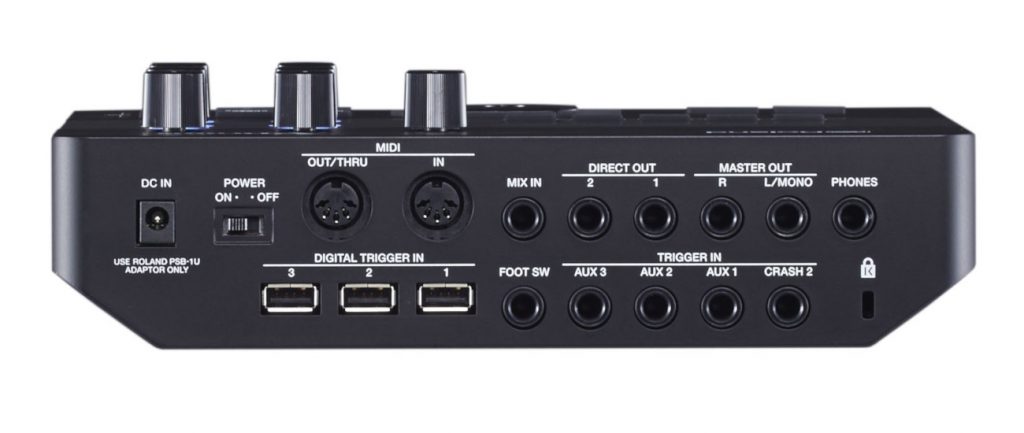
The TD-27 also has three digital inputs over USB. However, they are not in addition to the traditional TRS jack inputs. When you plug in a digital snare, ride or hi-hat via USB, the corresponding TRS jack input is disabled.
Unfortunately, that means you can’t use the snare jack on the cable snake as a secondary snare pad in addition to the digital snare, it’s a hard limit of 12 different playing surfaces on the module itself. However, this is a generous amount of inputs – two more than the older TD-25 and more budget-oriented TD-17.
What audio outputs does the TD-27 module have?
The TD-27 module has separate ports for headphones, master out and direct out. In basic terms, the three output options can be used for different things:
- Headphones: for monitoring your own drums
- Master out: For mono or stereo amplified speakers
- Direct out: For sending specific instruments like the kick or snare to a different channel on a PA mixer for individual EQ or other adjustments</ul>
The TD-27 features an Audio Output Assignment menu found under system > output where it’s possible to customise what sounds are output to each.
Here, you can specify the amount of reverb and other effects piped through each output, or even specify which pads are output to which output, for example, if you want to split out the snare and kick drums to separate direct outs.
The three outputs offer tons of flexibility for routing your audio depending on what you want. Some examples include:
Performing while playing to a click or backing track
- Set the headphone output to output the module metronome plus mix-in or USB audio in, plus drum sounds
- Set the master out to output only the backing track via the mix-in or USB in, which can then be plugged into a mixer via a stereo input
- Set up the direct out with the drum sounds, which again can be plugged into a stereo input on the mixer
Performing with a click, sending audio to the monitors and front-of-house PA
- Set the headphone output to play the drum sounds plus click track from the module metronome
- Set the master out to play all audio except the click and route to your on-stage monitors
- Set the direct out to play all audio except the click and route to your front-of-house PA
Performing with a click, splitting out the kick and snare for your sound engineer to EQ
- Set the headphone output to play the drum sounds plus click track from the module metronome
- Set the master out to play all audio except the kick and snare
- Set the kick to direct out 1 and snare to direct out 2, so they can be independently EQd by your engineer</ul>
The module also features three volume controls to help you manage the audio coming in and out:
- Backing: adjusts the volume of backing tracks played via the module’s player, via the mix-in jack, or via Bluetooth
- Phones: adjusts the volume of the headphone output
- Master: adjusts the volume for the master output jacks
All in all, the TD-27 is a step up on the TD-17 which doesn’t have any direct outs and has no audio routing control. This means the TD-27 is the better option if you need a more complex audio routing solution, whether for playing live or recording your own drum covers and videos.
About digital pad support
If you’re not planning on using the built-in sounds, then the TD-27 is a great drum module for VST use thanks to the digital pad support. These pads result in accurate triggering beyond what is capable with a standard pad.
The best example of this is the snare drum. The pad can distinguish between a rim click and a rim shot automatically, and even trigger rim shots of varying strength depending on how hard you play, just like a real drum. And as with older Roland pads, the snare supports positional sensing.
Similarly, the ride supports positional sensing and can be muted by placing a hand over the top of the pad.
Meanwhile, the brand-new digital hi-hat features higher-resolution triggering than previous Roland hi-hats, with 360-degree triggering with a choke function, and the ability to sense how firmly you’re pressing down on the pedal – not just how closed the hi-hats are.
Can digital inputs be used at the same time as analogue inputs?
The digital trigger inputs cannot be used at the same time as the corresponding analogue inputs. For example, if you have a digital ride cymbal plugged in using USB, you cannot also use the dual-analogue ride input. Similarly, if you are using a digital hi-hat on the newly released VAD 504 or 507, you cannot also plug in an analogue hi-hat pad.
How does Bluetooth work on the TD-27 module?
The Bluetooth support on the TD-27 allows drummers to connect their smartphones and play along to music, the same as the stereo mix-in port on the module, but wireless.
Be aware that the Bluetooth interface cannot be used for connecting Bluetooth headphones to hear your drums wirelessly, it can only be used as a mix input. Learn why in our article about Bluetooth headphones and eDrums.
How do I connect my Roland TD-27 to my computer?
The best way to connect the TD-27 to a computer is via USB, which allows you to transmit MIDI or multi-channel audio to your recording software. You can also configure the module’s headphones and other output ports to play back sounds from the computer. This allows you to monitor your recording via your TD-27’s headphone output, or could be used to route a backing track through your module and to the PA.
The module also includes MIDI in and out ports, however using this to connect to your computer would require a separate USB MIDI interface, and does not allow for any of the audio recording or playback features mentioned above.
Which TD-27 drum kit should you buy?
The TD-27 module is available in a few different packages, ranging from traditional electronic kits, the V.A.D. series, and even an upgrade pack for owners of older electronic drum sets.
TD-27K
The TD-27K is the cheapest kit in the range and does not include any of the digital pads, substituting them with a 10-inch snare (PDX-100), 13-inch Ride (CY-13R) and 12-inch Hi-hat (VH-10). This kit is best avoided as without the digital pads, it does not make the most of the power of the TD-27 module. The cheaper TD-17KVX is a better option if you’re not planning on upgrading your kit, as it comes with a larger 12-inch snare, while all other pads are the same.
TD-27KV
This mid-tier kit adds the digital snare and ride cymbal, alongside higher-spec tom pads. This is the cheapest TD-27 kit you should consider to really make the most of the power of the TD-27 module. However, if you can afford to stretch to the KV2, we would recommend it.
TD-27KV2
The KV2 is the latest SKU of the TD-27 range and was introduced alongside the new digital hi-hats in 2022, with these new 14-inch pads replacing the older VH-10 hi-hats. If you’re not interested in the V.A.D series, this is the ultimate TD-27 kit you can currently buy.
V.A.D. 504
The V.A.D. series is Roland’s mid-range acoustic-style electronic drum kit range, and the 504 is the update on the 503, adding the new digital hi-hats. The kit features full-sized acoustic shells with a 20-inch bass, 10, and 14-inch toms, and the 14-inch snare, plus a 14-inch crash accompanying the digital hats and ride.
This is the kit to get if you want an acoustic-style 4-piece electronic kit – it’s cheaper to add the CY-16RT for $399 than spending $1100 extra for the 507.
V.A.D 507
The V.A.D. 507 is the same as the 504, adding a 12-inch tom and 16” crash cymbal. This is the kit to get if you want the extra rack tom, though if you already have drum hardware, you could also consider buying the 504, and additional drums and cymbal pads separately.
The 12-inch PDA120-MA drum and the CY-16R-T pads can be purchased for $539 and $399 respectively. With the 503 costing $4299, you could build the 507 bundle yourself for $5,237, while the “official” 507 costs 5399 – a saving of $162 if you don’t need to buy a cymbal/tom stand.
TD-27 upgrade pack
Roland also sells an upgrade pack which comes with the module and all three digital pads. However, it is very poor value for money as it’s only a couple hundred less than the KV2 package. Clearly, Roland would prefer customers buy a complete drum kit from them, so a more cost-effective solution would be to buy a new kit and then sell the pads you don’t need.
TD-27 module only
The module can be purchased on its own and is an option for anyone looking to buy pads from another manufacturer, if you already have drum pads, or if you want to convert your own drum shells to electronic pads.
FAQs
What alternatives are there to the TD-27?
Within the Roland range, it’s worth considering if the lower or higher-end options are better for your needs:
- The TD-17KVX is better than the TD-27K if you are on a budget. Read our TD-17 review.
- The TD-50K2 if you absolutely need 2 extra trigger inputs and some extra pro-level features. Though for most buyers, the TD-27KV2 is the better choice
- The V.A.D. 706 if you’re considering a V.A.D. 503 or 507, and are willing to spend more for Roland’s flagship.</ul>
If you’re also considering non-Roland kits, then you might want to try some of the following:
- Yamaha DTX 8K-M
- Yamaha DTX 10K-X
- EFnote 5
- EFnote 5X
- ATV aDrums Artist Series</ul>
Featured image credit: Roland
This article contains affiliate links. If you purchase a product through certain links on our site, we may earn a small affiliate commission. Learn more about our adverts and why you can trust eDrumHub here.
